Star apple, Caimito
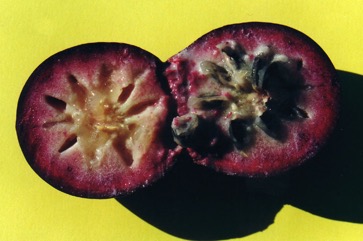
A tropical plant. It suits the hot, tropical lowlands with medium to high rainfall. It is native to tropical America. They are suitable for damp districts probably below 400 m altitude. They are grown at Kerevat in Papua New Guinea. It is drought and frost tender. It suits well drained soils, in a protected sunny position. Humid atmosphere and high temperatures throughout the year, suit the tree best. It has been grown up to 1,000 m altitude in South India. Young trees need cold protection but mature trees can survive cool temperatures. In XTBG Yunnan. It suits hardiness zones 11-12.
Also known as:
Aguay, Ajara, Apra, Buis, Caimite, Caimitero, Caimitier, Caimito-roxo, Caimo, Caini, Cainit, Cainito, Caymito, Chicle durian, Damsel, Epal feleppin, Estrella, Guayabillo, Hnin-thagya, Isi, 'istal 'apel, Kaimit, Kenitu, Macoucou, Murucuja, Olivoa, Pied caimite, Pohon sawo duren, Pomme surette, Rata lawulu, Star'apra, Sterappel, Star plum, Taroka phol, Thituy, Tuk dah koo, Vu sua
Synonyms
- Cainito pomiferum Tussac
- Chrysophyllum bicolor Poir.
- Chrysophyllum sericeum Salisb.
- Cynodendron bicolor (Poir.) Baehni
- and many others
Edible Portion
- Fruit, Seeds
Where does Star apple grow?
Found in: Africa, Argentina, Asia, Australia, Bangladesh, Barbados, Belize, Bermuda, Brazil, Cambodia, Cameroon, Caribbean, Cayman Islands, Central Africa, Central America, China, Colombia, Cook Islands, Costa Rica, Côte d'Ivoire, Cuba, Dominican Republic, East Africa, El Salvador, Fiji, FSM, Ghana, Guatemala, Guiana, Guianas, Guyana, Haiti, Hawaii, Honduras, India, Indochina, Indonesia, Ivory Coast, Jamaica, Laos, Malaysia, Mariana Islands, Marquesas, Mexico, Mozambique, Myanmar, Nauru, Nicaragua, North America, Northeastern India, Pacific, Pakistan, Panama, Papua New Guinea, PNG, Peru, Philippines, Pohnpei, Puerto Rico, Samoa, SE Asia, Sierra Leone, Singapore, Solomon Islands, South America, Sri Lanka, St Lucia, Suriname, Tanzania, Thailand, Tonga, Trinidad & Tobago, United States, Vanuatu, Venezuela, Vietnam, Virgin Islands, West Africa, West Indies
Notes: The tree is often grown as an ornamental because of the attractive golden underside to the leaves. There are about 80-150 Chrysophyllum species. They are mostly in tropical America. There are 44 species in tropical America.
Status: It is a cultivated food plant. At present not widely grown or used in Papua New Guinea. It is cultivated throughout Thailand.
Growing Star apple, Caimito
Cultivation: Trees are grown from seeds. Seed can be stored for several months. Seed germinate well if planted fresh. Germination takes about 6 weeks. Trees grown from seed, give a variation in fruit quality and size. Fruit need to ripen on the tree. Trees are not normally pruned. Budding and grafting have been used. Cuttings will grow if taken from well ripened small shoots and grown in strong moist heat. Plants can be grown by layering. Trees are usually self-fertile.
Edible Uses: The flesh of the fruit is eaten fresh when fully ripe. The skin has a gummy substance so the flesh of the fruit should be spooned out. The flesh of the fruit is sometimes added to salads and drinks. The fruit can be parboiled and also made into preserves. The seeds are sometimes eaten in confectionary. An emulsion of the kernels can be made into a sweets. Caution: The seeds contain a cyanogenic glucoside.
Production: It is a slow growing tree. Trees planted from seed come into bearing in 5-9 years. Grafted trees bear in 4-5 years. Fruit mature in about 180 days. Yields of 70 kg or fruit per tree per year have been recorded. The fruit do not drop and must be picked. They can be stored for 3 weeks at cool temperatures.
Nutrition Info
per 100g edible portion| Edible Part | Energy (kcal) | Protein (g) | Iron (mg) | Vitamin A (ug) | Vitamin c (mg) | Zinc (mg) | % Water |
|---|---|---|---|---|---|---|---|
| Fruit | 68 | 1.8 | 0.5 | 20 | 11 | - | 82.8 |
Star apple, Caimito Photos

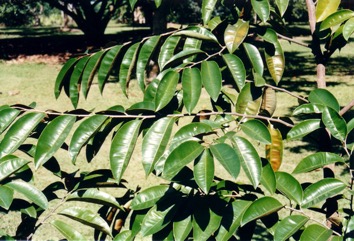
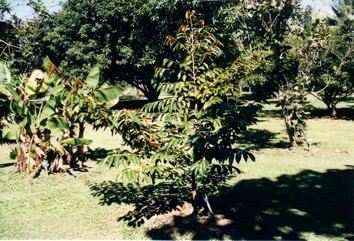
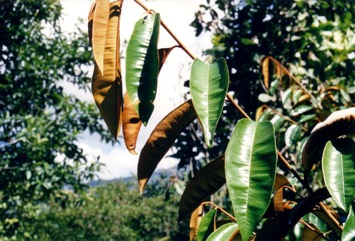
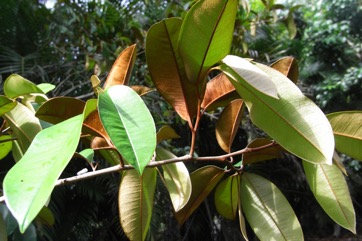
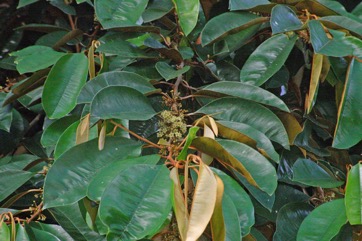
References
Abbiw, D.K., 1990, Useful Plants of Ghana. West African uses of wild and cultivated plants. Intermediate Technology Publications and the Royal Botanic Gardens, Kew. p 42
Ambasta, S.P. (Ed.), 2000, The Useful Plants of India. CSIR India. p 122
Arora, R. K., 2014, Diversity in Underutilized Plant Species - An Asia-Pacific Perspective. Bioversity International. p 62
Ashton, M. S., et al 1997, A Field Guide to the Common Trees and Shrubs of Sri Lanka. WHT Publications Ltd. pdf p 361
Barwick, M., 2004, Tropical and Subtropical Trees. A Worldwide Encyclopedic Guide. Thames and Hudson p 112
Bodkin, F., 1991, Encyclopedia Botanica. Cornstalk publishing, p 256
Bodner, C. C. and Gereau, R. E., 1988, A Contribution to Bontoc Ethnobotany. Economic Botany, 43(2): 307-369
Burkill, H. M., 1985, The useful plants of west tropical Africa, Vol. 5. Kew.
Call, C. A., et al, 2004, Participatory Rural Appraisal in the Upland Ecosystem of Mt Malindang, Misamis Occidental, Philippines. Biodiversity Research Programme for Development in Mindanao. p 60
Chakraborty, S. & Chaturbedi, H. P., 2014, Some Wild Edible Fruits of Tripura- A Survey. Indian Journal of Applied research. (4) 9
Chandrashekara, U. M., 2009, Tree species yielding edible fruit in the coffee-based homegardens of Kerala, India: their diversity, uses and management. Food Sec. 1:361-370
Chizmar Fernandez, C., et al, 2009, Plantas comestibles de Centroamerica. Instituto de Biodiversidad, Costa Rica. p 285
Coe, F. G., and Anderson, G. J., 1996, Ethnobotany of the Garifuna of Eastern Nicaragua. Economic Botany 50(1) pp 71-107
Coe, F. G. and Anderson, G. J., 1999, Ethnobotany of the Sumu (Ulwa) of Southeastern Nicaragua and Comparisons with Miskitu Plant Lore. Economic Botany Vol. 53. No. 4. pp. 363-386
Condit, R., et al, 2011, Trees of Panama and Costa Rica. Princeton Field Guides. p 436
Coronel, R.E., 1982, Fruit Collections in the Philippines. IBPGR Newsletter p 6
Cundall, P., (ed.), 2004, Gardening Australia: flora: the gardener's bible. ABC Books. p 377
Darley, J.J., 1993, Know and Enjoy Tropical Fruit. P & S Publishers. p 104
Ekman Herbarium records Haiti
Engel, D.H., & Phummai, S., 2000, A Field Guide to Tropical Plants of Asia. Timber Press. p 97
Etherington, K., & Imwold, D., (Eds), 2001, Botanica's Trees & Shrubs. The illustrated A-Z of over 8500 trees and shrubs. Random House, Australia. p 211
Facciola, S., 1998, Cornucopia 2: a Source Book of Edible Plants. Kampong Publications, p 226
Flora of Pakistan. www.eFloras.org
Flowerdew, B., 2000, Complete Fruit Book. Kyle Cathie Ltd., London. p 162
Food Composition Tables for use in East Asia FAO http://www.fao.org/infoods/directory No. 1003
French, B.R., 1986, Food Plants of Papua New Guinea, A Compendium. Asia Pacific Science Foundation p 295
Garner, R.J., and Chaudhri, S.A., (Ed.) 1976, The Propagation of Tropical fruit Trees. FAO/CAB. p 314
Hearne, D.A., & Rance, S.J., 1975, Trees for Darwin and Northern Australia. AGPS, Canberra p 43
Hedrick, U.P., 1919, (Ed.), Sturtevant's edible plants of the world. p 188
Hermandez Bermejo, J.E., and Leon, J. (Eds.), 1994, Neglected Crops. 1492 from a different perspective. FAO Plant Production and Protection Series No 26. FAO, Rome. p 17
Hibbert, M., 2002, The Aussie Plant Finder 2002, Florilegium. p 67
Hu, Shiu-ying, 2005, Food Plants of China. The Chinese University Press. p 619
Jackes, B.R., 2001, Plants of the Tropics. Rainforest to Heath. An Identification Guide. James Cook University. p 81
Jardin, C., 1970, List of Foods Used In Africa, FAO Nutrition Information Document Series No 2.p 127
John, L., & Stevenson, V., 1979, The Complete Book of Fruit. Angus & Robertson p 267
Kiple, K.F. & Ornelas, K.C., (eds), 2000, The Cambridge World History of Food. CUP p 1858
Lazarides, M. & Hince, B., 1993, Handbook of Economic Plants of Australia, CSIRO. p 59
Lembaga Biologi Nasional, 1977, Buah-Buahan, Balai Pustaka, Jakarta. p 116
Little, E. L., et al, 1974, Trees of Puerto Rico and the Virgin Islands. USDA Handbook 449. Forestry Service. p 780 (As Chrysophyllum bicolor)
Lorenzi, H., Bacher, L., Lacerda, M. & Sartori, S., 2006, Brazilian Fruits & Cultivated Exotics. Sao Paulo, Instituto Plantarum de Estuados da Flora Ltda. p 616
Macmillan, H.F. (Revised Barlow, H.S., et al) 1991, Tropical Planting and Gardening. Sixth edition. Malayan Nature Society. Kuala Lumpur. p 296
Martin, F. W., et al, 1987, Perennial Edible Fruits of the Tropics. USDA Handbook 642 p 59
Martin, M.A., 1971, Introduction L'Ethnobotanique du Cambodge. Centre National de la Recherche Scientifique. Paris.
McLaughlin, J., Woody and Herbaceus Plants Native to Haiti. University of Florida. p 19
Melander, M., 2007, Endangered plants on the market in Havana City, Cuba. Uppsala University, Sweden p 19
Miguel, E., et al, 1989, A checklist of the cultivated plants of Cuba. Kulturpflanze 37. 1989, 211-357
Morton, Julia F., 1987, Fruits of Warm Climates. Creative Resources Systems, Inc. . p. 408
Mutchnick, P. A. and McCarthy, B. C., 1997, An Ethnobotanical Analysis of the Tree Species Common to the Subtropical Moist Forests of the Peten, Guatemala. Economic Botany, Vol. 51, No. 2, pp. 158-183
Norrington, L., & Campbell, C., 2001, Tropical Food Gardens. Bloomings Books. p 117
NYBG herbarium "edible"
Omawale, 1973, Guyana's edible plants. Guyana University, Georgetown p 46
Pasha, M. K. & Uddin, S. B., 2019, Minor Edible Fruits of Bangladesh. Bangladesh J. Plant Taxon. 26(2): 299–313
Paz, F. S., et al, 2021, Edible Fruit Plant Species in the Amazon Forest Rely Mostly on Bees and Beetles as Pollinators. Journal of Economic Entomology, XX(XX), 2021, 1–13
Pham-Hoang Ho, 1999, An Illustrated Flora of Vietnam. Nha Xuat Ban Tre. p 630
Phon, P., 2000, Plants used in Cambodia. © Pauline Dy Phon, Phnom Penh, Cambodia. p 152
Plants of Haiti Smithsonian Institute http://botany.si.edu/antilles/West Indies
Priyadi, H., et al, Five hundred plant species in Gunung Halimun Salak National Park West Java. A checklist including Sundanese names, distribution and use. CIFOR, FFPRI, SLU p 153
Purseglove, J.W., 1968, Tropical Crops Dicotyledons, Longmans. p 646
Segura, S., et al, 2018, The edible fruit species in Mexico. Genet Resour Crop Evol (2018) 65:1767–1793
Slik, F., www.asianplant.net
Solomon, C., 2001, Encyclopedia of Asian Food. New Holland. p 364
Solomon Islands Ministry of Agriculture, 1996, Solomon Islands: Country report to the FAO International Technical Report of Plant Genetic Resources. Leipzig. p 23
Sosef, M. S. M., Hong, L. T., & Prawirohatmodjo, S., (Eds.), 1998, Timber tree: Lesser-known timbers. Plant Resources of South-East Asia, 5(3), p 140
Sp. pl. 1:192. 1753
Staples, G.W. and Herbst, D.R., 2005, A tropical Garden Flora. Bishop Museum Press, Honolulu, Hawaii. p 518
Sukarya, D. G., (Ed.) 2013, 3,500 Plant Species of the Botanic Gardens of Indonesia. LIPI p 195
Tankard, G., 1990, Tropical fruit. An Australian Guide to Growing and using exotic fruit. Viking p 30
Thaman, R. R., et al, 1994, The Flora of Nauru. Atoll Research Bulletin No. 392. Smithsonian Institute p 194
Triono, T., et al, 2007, A phylogeny of Pouteria (Sapotaceae) from Malesia and Australasia. Australian. Systematic Botany. 20:107-118
USDA, ARS, National Genetic Resources Program. Germplasm Resources Information Network - (GRIN). [Online Database] National Germplasm Resources Laboratory, Beltsville, Maryland. Available: www.ars-grin.gov/cgi-bin/npgs/html/econ.pl (10 April 2000)
Van Sam, H. et al, 2008, Uses and Conservation of Plant Species in a National Park. A case study of Ben En, Vietnam. Economic Botany 62:574-593
van Roosmalen, M.G.M., 1985, Fruits of the Guianan Flora. Utrecht Univ. & Wageningen Univ. p 404
Vivien, J., & Faure, J.J., 1996, Fruitiers Sauvages d'Afrique. Especes du Cameroun. CTA p 327
World Checklist of Useful Plant Species 2020. Royal Botanic Gardens, Kew
Yuncker, T.G., 1959, Plants of Tonga, Bernice P. Bishop Museum, Hawaii, Bulletin 220. p 212
www.worldagroforestrycentre.org/treedb/
Zaldivar, M. E., et al, 2002, Species Diversity of Edible Plants Grown in Homegardens of Chibehan Amerindians from Costa Rica. Human Ecology, Vol. 30, No. 3, pp. 301-316
Zawiah, N. & Othaman, H., 2012, 99 Spesies Buah di FRIM. Institut Penyelidikan Perhutanan Malaysia. p 78